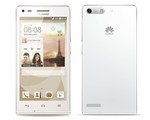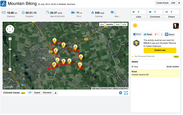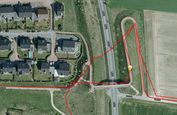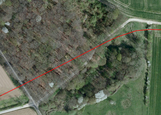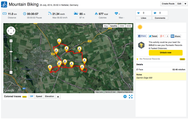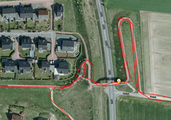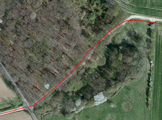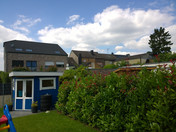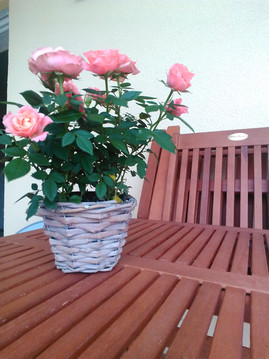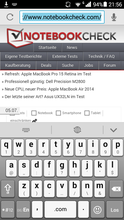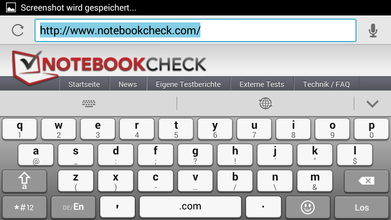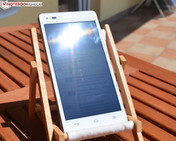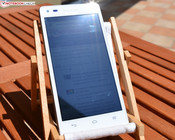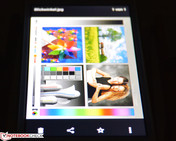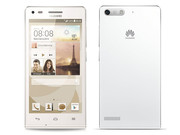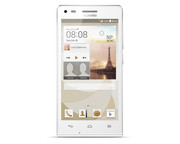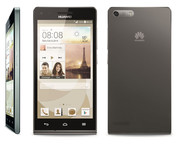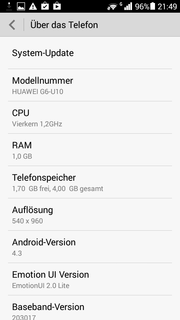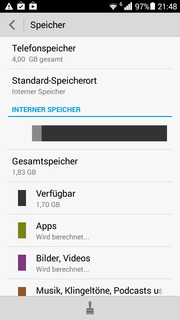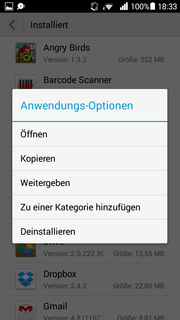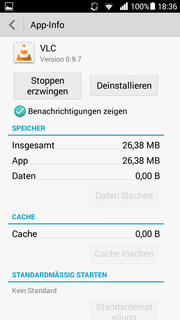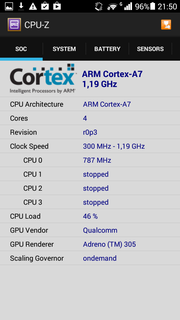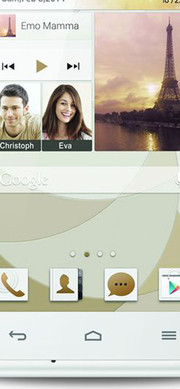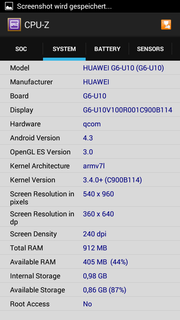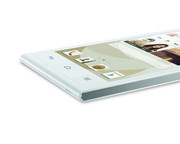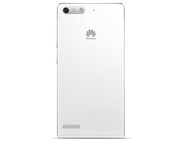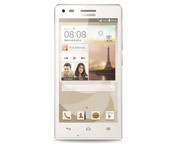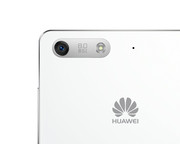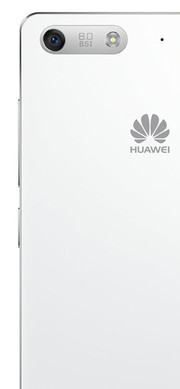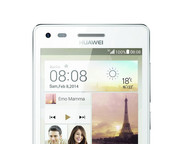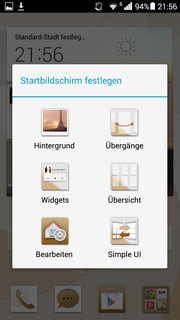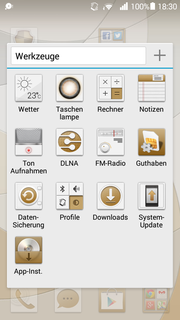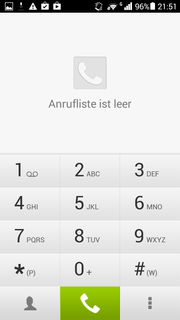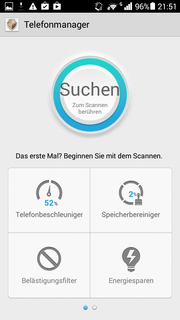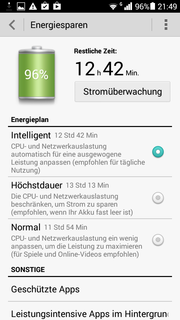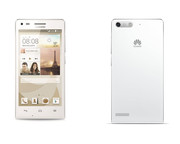Huawei Ascend G6 Smartphone Review
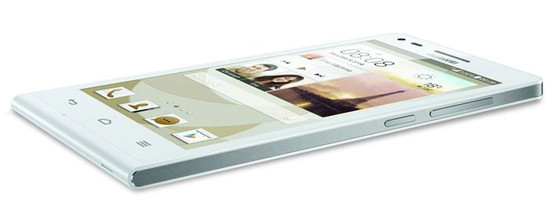
For the original German review, see here.
For those who fell in love with the stylish design of Huawei's Ascend P7 flagship but cannot or do not want to spend so much for it - the Chinese manufacturer has an alternative in its backpack. The brand new Huawei Ascend G6 looks a lot like its bigger brother and brings the elegant design language to the mid-range. The front-facing camera is still first rate. Although it does not have the Ascend P7's gigantic resolution of 8 MP, it still features a whole 5 megapixels, which lets it stick out from the masses of contenders. Otherwise, the Ascend G6 offers a solid configuration: A quad-core SoC with a clock rate of 1.2 GHz from Qualcomm and an integrated Adreno 305 graphics card meet 1 GB of RAM and 4 GB of internal flash storage. The smartphone is powered by Android 4.3 Jelly Bean. The 4.5-inch screen's resolution is a bit low. The bundle is rounded off by a microSD slot and stereo headset. Huawei demands 249 Euros (~$338, RRP) for this package.
Huawei's Ascend G6 thus competes against rivals like Acer's Liquid E3 E380, HTC's Desire 310, LG's L70, and Sony's Xperia M2.
Case
The casing looks just as elegant as Huawei's Ascend P7, but Huawei makes cuts in the materials here. The chassis is no longer entirely aluminum; it is now matte-white polycarbonate. The silver bezel is also made of plastic. Nevertheless, the smartphone is quite rigid and stiff and also well-built.
The review sample scores with a total weight of just 115 grams alongside very compact dimensions in the comparison. The casing is only 7.5 mm thick and thus undercuts most contenders.
In contrast to Huawei's Ascend P7, the G6 review sample's back can be removed. The battery cannot be removed anyway, and the user cannot replace it - a wasted chance.
Connectivity
Huawei's Ascend G6 provides interfaces typical for the category, such as a micro-USB 2.0 port on the device's upper edge, and the compulsory 3.5 mm jack that has been placed a bit unfavorably on the left. Besides that, the slots for a micro-SIM and micro-SD cards are underneath the back cover. The gently rippled physical buttons please with their good pressure point.
Software
Unfortunately, Huawei's Ascend G6 relies on the somewhat older Android 4.3 Jelly Bean. An update to Android 4.4 KitKat has not yet been announced. Besides that, Huawei overlays it with a proprietary interface dubbed Emotion UI 2.0 Life, which allows a pleasantly intuitive usage. Unlike stock Android, there is no overview of apps; all installed applications are placed on the home screen and can optionally be moved to folders. Backgrounds can be customized with ready-to-use designs or personal pictures.
Communication & GPS
Huawei treats the Ascend G6 to the most important communication modules in form of Wi-Fi b/g/n and Bluetooth 4.0 + EDR. Wi-Fi reception is stable, but its range could be higher. Furthermore, both GSM quad-band (850/900/1800/1900) and UMTS dual-band (900/2100) are available for on the go. UMTS achieves data rates of 21 Mbps in download and 5.76 Mbps in upload. The reception strength is stable to good.
The installed A-GPS module enables middling localization; the GPS Test app confirms a stable reception. Huawei's Ascend G6 satisfactorily performed the practical test using a bike and a direct comparison with the Garmin Edge 500 navigation system. The device clearly takes shortcuts particularly in difficult regions like when riding through the woods or in curvy sections.
Telephony & Speech Quality
The phone features largely correspond to the good Android standard. The speech and audio quality is good and only suffers under light background noise conditionally. The speaker's hands-free feature is, unfortunately, only useful in quiet surroundings because its volume is simply too low.
Cameras & Multimedia
The primary camera has a relatively high resolution of 8 megapixels and also features an auto-focus as well as LED flash. Videos are recorded in 1080p.
The direct comparison with the contenders reveals visible shortcomings, like a minor overexposure, slightly insufficient sharpness, and pale colors. However, useful pictures can be taken when the object is well illuminated and which are appealing particularly considering the price range.
The real star of Huawei's Ascend G6 is the front lens though. The rivals have a maximum resolution of 2 megapixels, in contrast to the review sample's fat 5 megapixels. Alongside the selfie assistant, very good self portraits are possible - as long as the lighting is good. Annoying image noise increases the darker it gets.
Accessories
A slightly higher category-standard is included: the smartphone, a modular power supply with USB cord, a quick-start guide, and a stereo headset.
Warranty
Huawei includes a 24-month warranty on its Ascend G6.
Input Devices & Controls
Display
The TFT in Huawei's Ascend G6 has a size of 4.5-inches and a rather low resolution of 960x540 pixels. Rivals like Acer's Liquid E3 offer an HD resolution. However, the screen scores with its average brightness of 416.8 cd/m² and maximum of 439 cd/m². This places the G6 in the upper midfield. Both Acer's Liquid E3 and Sony's Xperia M2 are approximately 40 to 50 cd/m² brighter. The review sample's illumination of 88% is good average, but the contenders - with the exception of HTC's Desire 310 - feature a slightly more homogeneous illumination.
| |||||||||||||||||||||||||
Brightness Distribution: 88 %
Center on Battery: 418 cd/m²
Contrast: 685:1 (Black: 0.61 cd/m²)
ΔE Color 6.34 | 0.5-29.43 Ø5
ΔE Greyscale 6.53 | 0.57-98 Ø5.3
Gamma: 2.11
The black level of 0.61 cd/m² and contrast of 685:1 are quite good in the mid-range. However, some rivals offer better rates particularly in black level. The bottom line is a subjectively good image impression.
Our measurements using the X-Rite i1pro 2 colorimeter and CalMAN software confirm a decent performance for the screen in Huawei's Ascend G6. Especially color hues are reproduced quite well and exhibit a barely visible shift in red and blue colors. The DeltaE of 6.34 underlines that. The color saturation, however, shows bigger shifts particularly in the yellow and green range. Then again, the Gamma of 2.11 is close to the ideal, and the color temperature of 7756 K is only marginally too high. The DeltaE of 6.53 in the grayscale is also a bit too high. The gradient shows a visible bluish cast. Our subjective impression: The listed shortcomings are barely visible in routine use.
The screen's maximum brightness of 439 cd/m² is principally high enough for outdoor use. The reliable, automatic brightness control contributes to that. The screen protector applied ex-factory is, unfortunately, not matte, and the ambient light is reflected quite intensely. However, content always remains well-legible as long as light does not shine directly on the screen.
Performance
Huawei's Ascend G6 relies on a Qualcomm Snapdragon 400 MSM8226 quad-core SoC with a clock rate of 1.2 GHz and integrated Adreno 305 graphics card alongside 1 GB of RAM. The SoC belongs to the entry level but is strong enough for multimedia applications and a few Android games that should, however, not be too demanding.
The review sample impressively ran through our synthetic benchmark course. It is on par with the contenders in the 3DMark Ice Storm benchmark and only clearly remains behind Sony's Xperia M2 in some cases. Huawei's Ascend G6 also pulls even with its rivals in AnTuTu v4 and Geekbench 3. It comes in second last in PassMark Performance Test Mobile and can only outperform LG's L70 slightly.
The review sample does a strikingly poor job in AndroBench 3 and even falls behind LG's L70. According to the test, the internal storage is very slow, but that is not very significant for routine use. Negative is that the internal storage only has about 1.8 GB net available, and most applications cannot be moved to the micro SD card from the outset. Thus, larger apps like some games cannot be downloaded at all.
| AnTuTu v4 - Total Score (sort by value) | |
| Huawei Ascend G6 | |
| HTC Desire 310 | |
| Sony Xperia M2 | |
| LG L70 | |
| Acer Liquid E3 / E380 | |
| Geekbench 3 | |
| 32 Bit Multi-Core Score (sort by value) | |
| Huawei Ascend G6 | |
| HTC Desire 310 | |
| Sony Xperia M2 | |
| LG L70 | |
| Acer Liquid E3 / E380 | |
| 32 Bit Single-Core Score (sort by value) | |
| Huawei Ascend G6 | |
| HTC Desire 310 | |
| Sony Xperia M2 | |
| LG L70 | |
| Acer Liquid E3 / E380 | |
| AndroBench 3-5 | |
| Random Write 4KB (sort by value) | |
| Huawei Ascend G6 | |
| HTC Desire 310 | |
| Sony Xperia M2 | |
| LG L70 | |
| Acer Liquid E3 / E380 | |
| Random Read 4KB (sort by value) | |
| Huawei Ascend G6 | |
| HTC Desire 310 | |
| Sony Xperia M2 | |
| LG L70 | |
| Acer Liquid E3 / E380 | |
| Sequential Write 256KB (sort by value) | |
| Huawei Ascend G6 | |
| HTC Desire 310 | |
| Sony Xperia M2 | |
| LG L70 | |
| Acer Liquid E3 / E380 | |
| Sequential Read 256KB (sort by value) | |
| Huawei Ascend G6 | |
| HTC Desire 310 | |
| Sony Xperia M2 | |
| LG L70 | |
| Acer Liquid E3 / E380 | |
In the browser-based benchmarks, the review sample can only outperform its contenders slightly in SunSpider 1.0 and Peacekeeper. Its rivals are usually at the front in the other benchmarks. The Ascend G6 is particularly outclassed in Octane V2 and Web XPRT 2013. This speed shortage is not noticed very much in routine use; browsing is a lot of fun.
| Mozilla Kraken 1.1 - Total (sort by value) | |
| Huawei Ascend G6 | |
| Sony Xperia M2 | |
| LG L70 | |
| HTC Desire 310 | |
| Acer Liquid E3 / E380 | |
| Octane V2 - Total Score (sort by value) | |
| Huawei Ascend G6 | |
| LG L70 | |
| HTC Desire 310 | |
| Acer Liquid E3 / E380 | |
| Peacekeeper - --- (sort by value) | |
| Huawei Ascend G6 | |
| Sony Xperia M2 | |
| LG L70 | |
| HTC Desire 310 | |
| Sunspider - 1.0 Total Score (sort by value) | |
| Huawei Ascend G6 | |
| Sony Xperia M2 | |
| LG L70 | |
| HTC Desire 310 | |
| Acer Liquid E3 / E380 | |
* ... smaller is better
Games
The installed Qualcomm Adreno 305 graphics solution is not exactly synonymous with high-performance graphics; nevertheless undemanding games run smoothly as our sample tests confirm. The touchscreen does not thwart gaming fun and implements commands accurately and swiftly. The position sensor and accelerometer also function reliably.
Emissions
Temperature
Huawei's Ascend G6 is absolutely inconspicuous when idling and always stays cool. When high requirements are placed on the smartphone, for example, in some games, it heats up to a noticeable 36 to 38 °C on average. It reaches a maximum of approximately 42 °C.
(±) The maximum temperature on the upper side is 42.2 °C / 108 F, compared to the average of 35 °C / 95 F, ranging from 21.9 to 56 °C for the class Smartphone.
(±) The bottom heats up to a maximum of 41.1 °C / 106 F, compared to the average of 33.8 °C / 93 F
(+) In idle usage, the average temperature for the upper side is 30.5 °C / 87 F, compared to the device average of 32.7 °C / 91 F.
Speakers
The integrated mono speaker supplies a somewhat treble-heavy sound that lacks bass and mids. The maximum volume is enough for the near field in a quiet surrounding. It could, however, be higher for the hands-free feature or videos. The 3.5 mm jack provides a low-noise sound and decent volume.
Energy Management
Power Consumption
The G6 proves to be very frugal in power consumption in the category comparison. Only LG's L70 requires a bit less power; however, its screen is not as bright.
| Off / Standby | |
| Idle | |
| Load |
|
Battery Runtime
The battery of Huawei's Ascend G6 is non-removable and supplies a capacity of 2000 mAh. Thus, it is on par with Acer's Liquid E3 and HTC's Desire 310 in the comparison field. LG's L70 (2100 mAh) and Sony's Xperia M2 (2330 mAh) both have a slightly higher capacity.
The review sample can also convert the low power requirement very efficiently, and it thrills with 9:20 hours in the browsing test. We perform the test via Wi-Fi using a brightness set to 150 cd/m². Only the stronger Sony Xperia M2 lasts 2 hours longer; the other rivals shut down earlier. Huawei's Ascend G6 has to be recharged after 3:22 hours of full load, simulated with the Stability Test app. Again, all contenders can either pull even or surpass the review sample.
The possible battery runtime makes it easy to use the review sample for a whole workday, without the need for recharging it. The G6 also serves with useful energy-saving features that can extend the runtime even more.
Verdict
Huawei's Ascend G6 costs around 180 Euros (~$244) and has quite a lot to offer at the time of writing. First, its compact, rigid, and well-processed casing alongside the stylish design. The bright, viewing-angle stable, 4.5-inch screen that remains well-legible even outdoors is also a positive. Since it operates energy efficiently despite that, it can also score with long battery runtimes. The smartphone is easy to use owing to the useful software features and the intuitive UI. The camera module lenses suffer under the sharpness and light deficiencies common in this price range but are compelling anyway. We very much liked the high-resolution front-facing camera besides the practical selfie assistant.
The tight internal storage is not very compelling. Therefore, it is even more devastating that there is no move-to-SD option for most apps. Large applications cannot be installed from the outset. The available application performance is more in the lower midfield, but the power is enough for most everyday situations. An up-to-date resolution for the screen would not hurt either. It would still be tolerable that the GPS performance only shows a mediocre accuracy, and that the speakers only provide a middling sound. It is, however, too bad that the maximum volume is quite low, and consequently the hands-free feature is too quiet in most cases, making it useless.
Huawei offers a decent smartphone with its Ascend G6, which will serve most users well. Buyers who do not need NFC, LTE or high performance, and do not place extremely high requirements on the device could be happy with it. However, some contenders, such as Motorola's Moto G simply offer considerably more for almost the same price.


 Deutsch
Deutsch English
English Español
Español Français
Français Italiano
Italiano Nederlands
Nederlands Polski
Polski Português
Português Русский
Русский Türkçe
Türkçe Svenska
Svenska Chinese
Chinese Magyar
Magyar